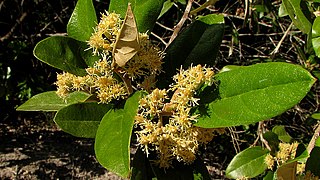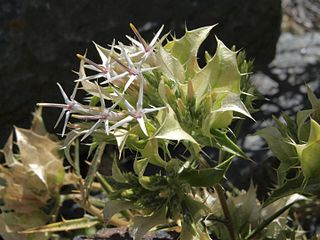
The family Asteraceae, with the original name Compositae, consists of over 32,000 known species of flowering plants in over 1,900 genera within the order Asterales. Commonly referred to as the aster, daisy, composite, or sunflower family, Compositae were first described in the year 1740. The number of species in Asteraceae is rivaled only by the Orchidaceae, and which is the larger family is unclear as the quantity of extant species in each family is unknown.

Nolina is a genus of tropical xerophytic flowering plants, with the principal distribution being in Mexico and extending into the southern United States. They are large, dioecious plants.

Dermatophyllum is a genus of three or four species of shrubs and small trees in the family Fabaceae. The genus is native to southwestern North America from western Texas to New Mexico and Arizona in the United States, and south through Chihuahua, Coahuila, and Nuevo León in northern Mexico. Members of the genus are commonly known as mescalbean, mescal bean, or frijolito. One of the common names of Dermatophyllum secundiflorum is Texas mountain laurel, although the name mountain laurel also refers to the very dissimilar and unrelated genus Kalmia and the name laurel refers generally to plants in the unrelated order Laurales. Dermatophyllum secundiflorum is one of the most abundant woody species in the Texas Hill Country or Edwards Plateau.

Marina is a genus in the legume family, Fabaceae. It includes 40 species native to southern North America, ranging from California and New Mexico through Mexico and Central America to Costa Rica. They are known as the false prairie clovers. Unlike the related prairie clovers, which bear two ovules per fruit, false prairie clovers bear only one ovule per fruit.

Distephanus is a genus of flowering plants in the family Asteraceae. It is described by American botanist Harold E. Robinson as having over 40 species and by David Mabberley as having only 34 species. These sources differ sharply in their description of the range of the genus. Robinson has it ranging throughout Africa and occurring also in India and China. Mabberley has it restricted to southeast Africa, Madagascar, and Mauritius.

The Gochnatioideae are a subfamily of the aster family, Asteraceae. It contains the single tribe Gochnatieae of six genera, with a total of about 80 to 90 species. They are native to the Americas from the southern United States to Argentina, including the Caribbean, and Cuba in particular.

Hecastocleis is a genus of low thorny shrubs with stiff branches, assigned to the daisy family. At the tip of each of the branches, inflorescences are subtended by oval, thorny, whitish to greenish bracts that enclose several flower heads which each contain only one pinkish bud, opening into a white corolla. It contains but one species, Hecastocleis shockleyi, the only representative of the tribe Hecastocleideae, and of the subfamily Hecastocleidoideae. Its vernacular name is prickleleaf. It is confined to the southwestern United States.
Setchellanthus caeruleus is a species of pungent shrub with large blue flowers. It is placed alone in the genus Setchellanthus, which is in turn, is placed alone in the family Setchellanthaceae. It is endemic to Mexico.

Lysiloma is a genus of flowering plants belonging to the family Fabaceae.

Calopogonium is a genus of flowering plants in the legume family, Fabaceae. It includes eight species, which range through the tropical Americas from Mexico through Central America, the Caribbean, and northern South America to northeastern Argentina. It belongs to the subfamily Faboideae.

Gochnatia is a genus of flowering plants in the daisy family, Asteraceae. It is named for botanist Frédéric Karl Gochnat. The genus contains mainly shrubs and subshrubs, with a few trees and herbs. All of the species are native to the American tropics. Two species native to the mountains of Southeast Asia and formerly included here are now separated as the genus Leucomeris in subfamily Wunderlichioideae.
Oreoseris is a genus of flowering plants in the family Asteraceae, native to Anatolia, Central Asia, the Himalaya region, and Thailand. Originally described in 1838, it was resurrected with the Asian species of Gerbera and all the species of Uechtritzia in 2018.

Corymbium is a genus of flowering plants in the daisy family comprising nine species. It is the only genus in the subfamily Corymbioideae and the tribe Corymbieae. The species have leaves with parallel veins, strongly reminiscent of monocots, in a rosette and compounded inflorescences may be compact or loosely composed racemes, panicles or corymbs. Remarkable for species in the daisy family, each flower head contains just one, bisexual, mauve, pink or white disc floret within a sheath consisting of just two large involucral bracts. The species are all endemic to the Cape Floristic Region of South Africa, where they are known as plampers.
Anastraphia is a genus of flowering plants in the family Asteraceae. It includes 33 species native to the Caribbean, including Cuba, Hispaniola, the Bahamas, and the Turks and Caicos Islands.

Vicki Ann Funk was an American botanist and curator at the Smithsonian's National Museum of Natural History, known for her work on members of the composite family (Asteraceae) including collecting plants in many parts of the world, as well as her synthetic work on phylogenetics and biogeography.
Nahuatlea hypoleuca, the shrubby bullseye, is a North American species of plants in the family Asteraceae. It is native to northern Mexico and just north of the Río Grande in Texas.

Gymnarrhenoideae is a subfamily within the family Asteraceae, with only one tribe, the Gymnarrheneae. Two very different species have been assigned to it, Gymnarrhena micrantha, a winter annual from the deserts of North-Africa and the Middle-East, and Cavea tanguensis, a perennial herb that grows on scree near streams and glaciers in the Eastern Himalayas. These species have very little in common, other than having two types of flower heads and sharing a tendency towards dioecism. Both also have basal leaf rosettes, stretched leaves, with few spaced teeth on the margin, and both lack spines and latex.

Gambelia is a genus of flowering plants in the Antirrhineae tribe of the plantain family commonly known as bush snapdragons. This genus is native to northwestern Mexico, particularly the Baja California Peninsula, but species are also found on the coast of Sonora, Guadalupe Island, and the Channel Islands of California. The genus is named in honor of William Gambel (1823–1849), an American naturalist, ornithologist, and botanist.

Nahuatlea aborescens is a species of tree in the Composite family endemic to the Cape region and Cerralvo Island of Baja California Sur, commonly known as ocote. It grows up to 8 meters tall, with monoecious tan-colored flowers and short, leafy branchlets. It was formerly in the genus Gochnatia, where it was known commonly as the tree gochnatia.
Vickia rotundifolia is a species of flowering plant in the sunflower family, Asteraceae. It is the sole species in genus Vickia. It is a subshrub or shrub native to the states of Rio de Janeiro, São Paulo, and Paraná in southeastern and southern Brazil.















